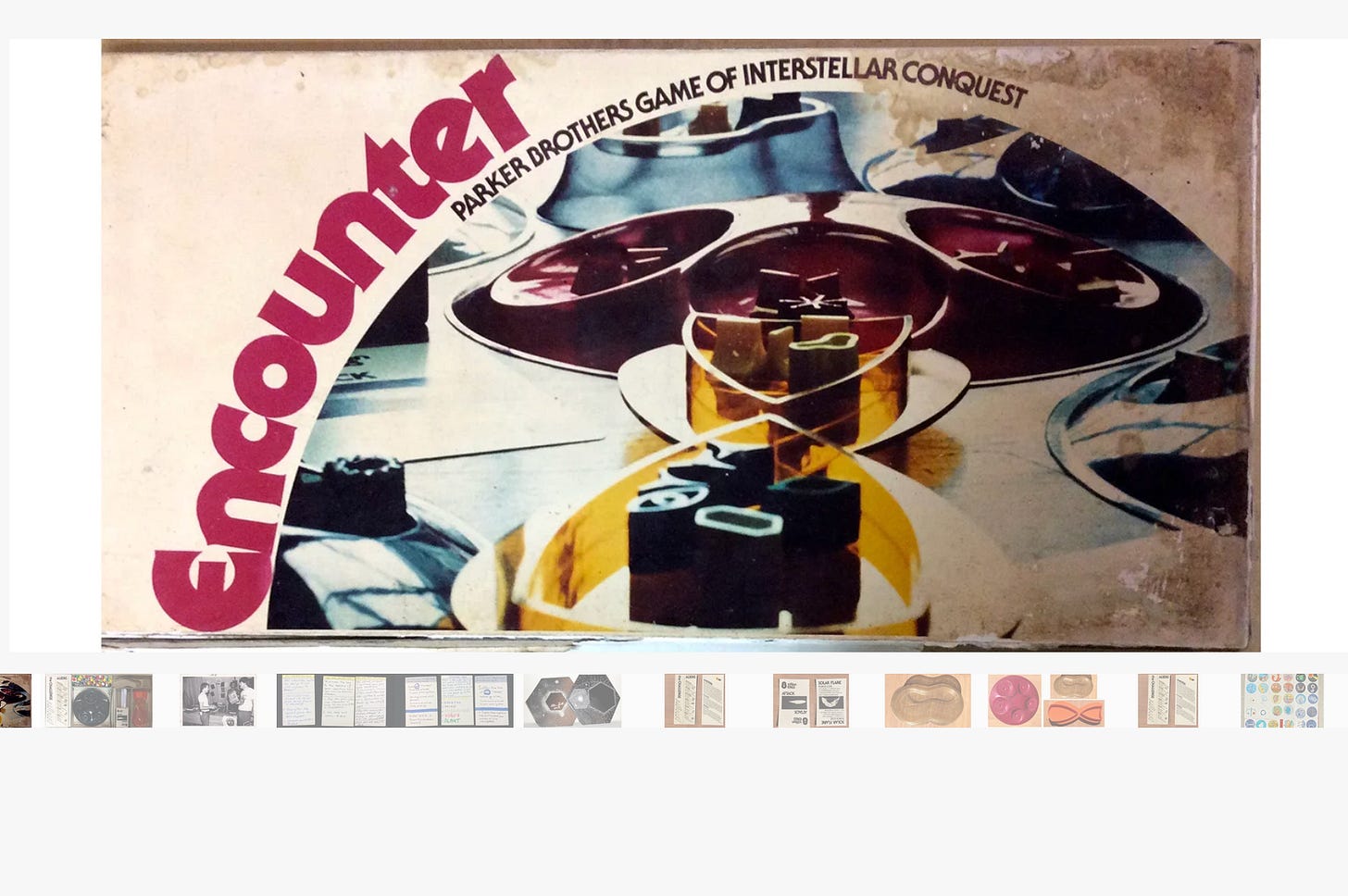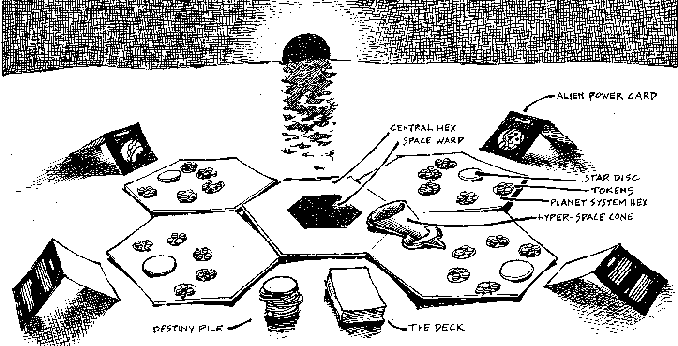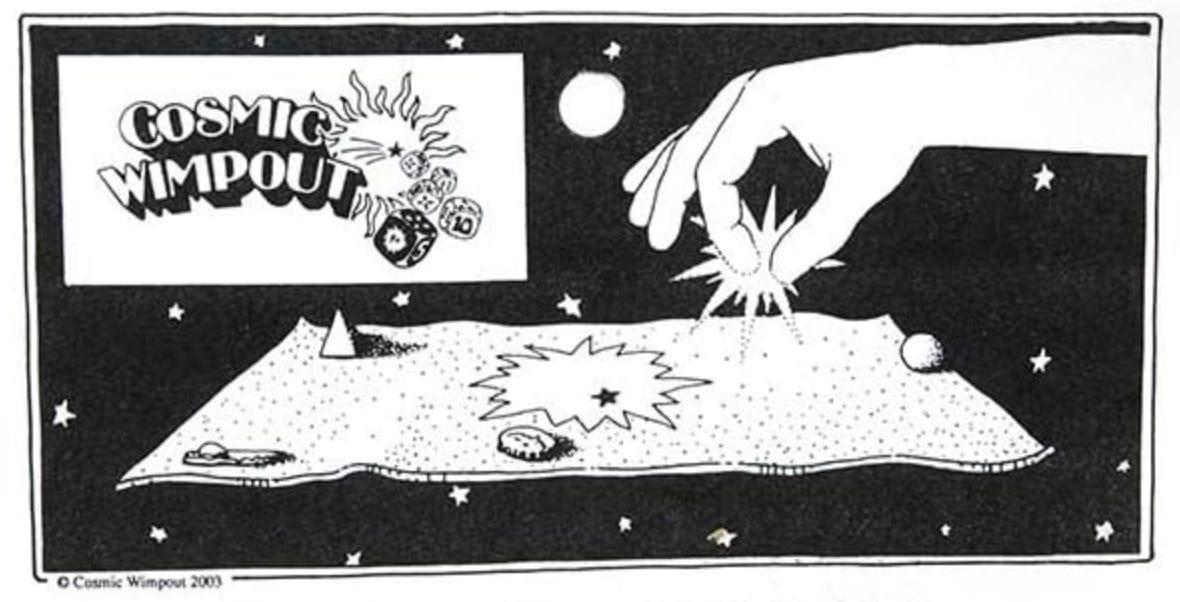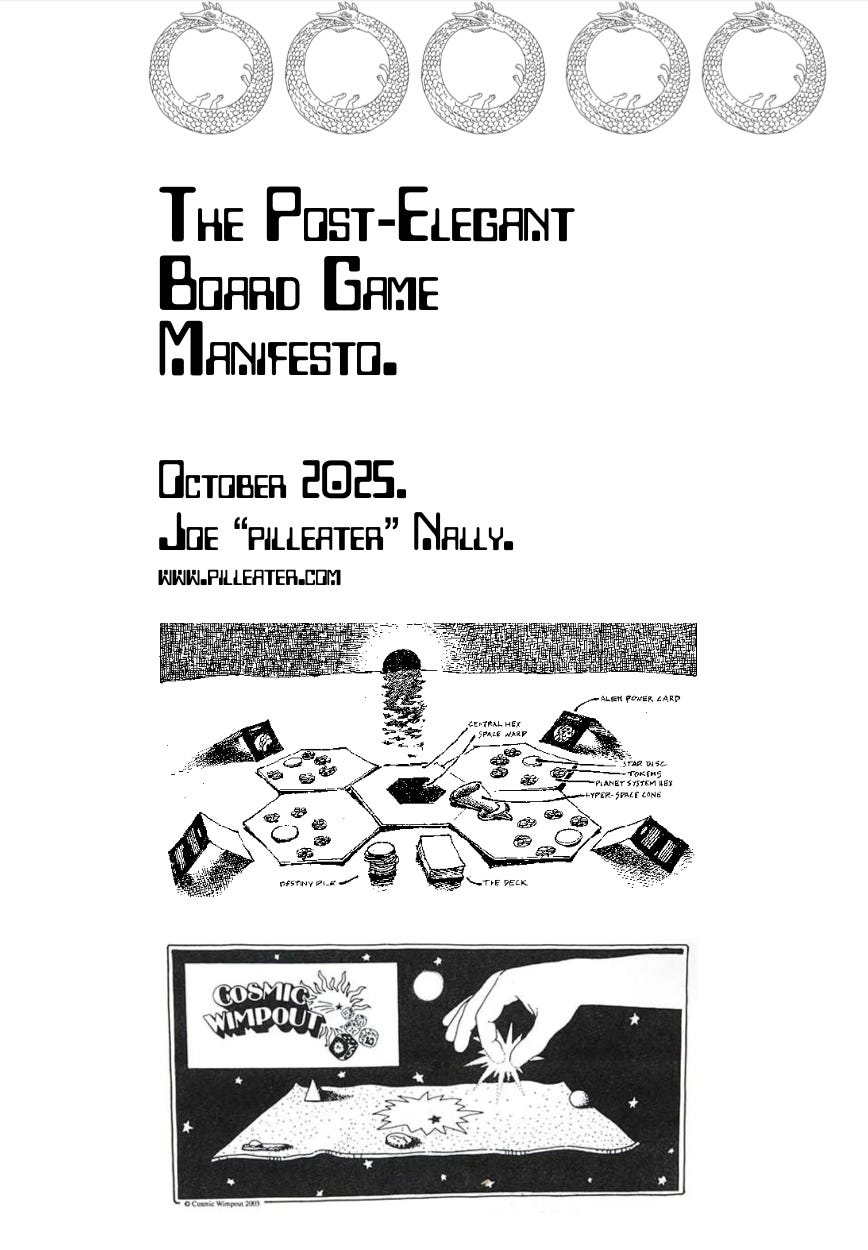The Post-Elegant Board Game Manifesto
What would make a board game "post-elegant?"
A MANIFESTO ABOUT THE COMING “POST-ELEGANT” DESIGN IN THE FUTURE OF BOARD GAMES AND ART TOYS.
….
“Post-elegance” can be described as the design paradigm after the obsession with simple interfaces and minimalism within board games. “Design” is a wide concept and is not limited to what can be operated by the components inside the box. Role-playing games use statistics and human imagination to create the limits that the players want. In a post-elegant board game, it fuses this infinite complexity along with human expression in the medium of the board game itself. The player is also an artist, and can use the board game’s medium to express himself against the tyranny of the calculated and cold mechanics of the Eurogame or computer.
What follows are key points that describe a post-elegant board game. Cosmic Encounter is often a great example that precedes the entire hobby of Role-playing games and the board game market. The 1970s were a time of uncharted territories, and nothing was solved like a puzzle. Instead of going in the direction of the game with a simple interface and complex results, we need a game that has a complex interface with simple results. These results influence other human players and not a computer or AI. Post-elegance is about interactivity and the board game components we supply meaning to. These are intimate games with uncertain outcomes and expressions, not puzzles with one conclusion.
The Post-elegant game is an artist’s game. Expressive, playful, complicated, and lifelong in study, just like Chess, Go, or Diplomacy. It is a real metaphor like Herman Hesse’s The Glass Bead Game.
The following is a list of possible characteristics that post-elegant games should have:
“Fun” is something subjective and not the whole. Rather, passion and self-discovery replace it.
The game should be exciting to other previous players when you mention its name before play.
You roll a die during the turn transition to see if the turn happens or not.
You roll a die to do something forcefully.
The board game design is exactly like sound design, where you make things up on top of each other until the clay becomes the image of a person (a desire or concept).
Everyone should have 20 tokens to use.
There should be a public deck of “take-that” number cards that everyone shares when drawing.
Everyone’s “tableau” is unique to each player, is asymmetrical, and cannot be replicated.
You can feel the components in your hands when you play and perform with actions.
A deck of playing cards should be appropriate at all times when resolving issues.
It simulates a mix between poker and a war game.
It is a role-playing game in a box with fixed components and ruleset within a universe where a player could win or lose in a session.
Every player acts as a gamemaster and overrides the game.
The game is like Diplomacy at the most basic and stripped-down level.
It is always random against the player’s will, but not unfair.
You can express yourself in the game, like an artist would with their creation.
There is zero downtime, where everyone has a say on the other player’s turn.
The spectator players, who are not the offense or the defense, can turn the game around with the right cards and actions.
There is no freewill in the game’s environment, but freewill within player expression.
There is constant compromise or attack against another player each turn.
You create allies through instant improv or through a committed long game.
Allie rules are non-abiding, although there can be abiding rules.
Perhaps use a card to indicate you are allied with that player.
There can be shared victories, or everyone can lose.
You can declare “peace” on a turn.
This is a slimmed-down and better version of Cosmic Encounter.
Player powers don’t affect digits and can only affect interactivity.
People come before math.
The game can go up to six players, and at a minimum, for three.
The game is best with four to five players.
There are 50 unique character powers.
During setup, three random character powers are given to the player, and the player selects one of them.
It is not the character power you role-play. These are rather player aids. The character power is just an asymmetrical, rule-breaking aid.
The players matter the most.
The robot or AI does not exist.
The game environment is modular, and rules can be added or taken away before play.
The game’s set up is its own play phase.
The problem of choosing a character is that there are hierarchies and there are correct choices, rather than expression. Therefore, character selection should be random, but player expression is infinite. Just like a “unique deck card game” like KeyForge.
“Use the tools that you have in the jungle in order to survive.”
You are not “customizing” the game. Rather, you are drafting what expansions and parts to use, like creating a modular synth.
The public “number card” deck is used for combat purposes.
The public deck of number cards is also shuffled, and six are dealt out to each player.
At the start of your turn, take one token back from the graveyard.
You are randomly dealt a conflict choice with another player. If you don’t want to deal with that player, both of you can make a deal before it starts.
When number cards are revealed between the two players, the other players who were allies may increase or decrease those values with other number cards in their hands.
You need five victory points to win the game at the end of the turn.
You always have a choice, but it’s actually based upon improv in a hostile and unpredictable environment.
There will be dice. And you will roll them.
Perhaps there should be a reference card that lists actions 1 through 6. Say, if you roll five six-sided dice, you look up the numbers, and that’s what you can do with each die. Choose each die and execute the action.
Players cannot be eliminated and still have a say in the game until it ends.
Every player will always be different.
And every game session will always be different.
The game will share an avant-garde aesthetic of rainbow colors and produce a creative “hallucination” and apparent expansion of consciousness.
Thinking is the main act of expression. The game will make players think, akin to starting any philosophical investigation.
Thinking leads to expression, which leads to better art and understanding of design and the intimacy of another human.
If you can do something in the game, then another player can do something else in return against that, or this triggers a certain beneficial action.
You can break the rules of the game and “cheat” against the entire system, just like you could do in a role-playing game.
The game takes cues from “I’m The Boss,” where there is no AI, but humans acting as the computer instead. It’s about humans relying on other humans.
Interactivity is between two or more human beings, and cannot be with another AI or machine. The latter is called “interface.” Interface is not interactivity.
To see what freedom from a computer means. The game should achieve that.
Humans supply meaning to the interface for other humans.
The game is only a ritual to interact, play, rank, learn, and express with other humans.
These points should clarify what kind of board game I would like to see in the future. It shall be an artsy board game that fulfills the seeking of wisdom and play. It is an artistic medium where the player also becomes an artist. The game is also a lifelong commitment.
I am still trying to understand these ideas in game design.
-pe
9-30-2025






